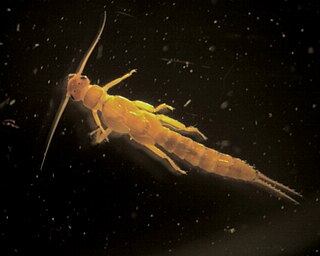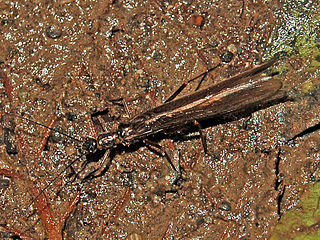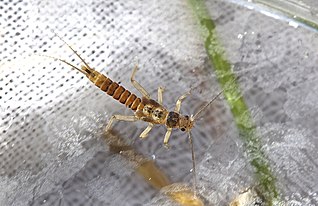
Plecoptera is an order of insects, commonly known as stoneflies. Some 3,500 species are described worldwide, with new species still being discovered. Stoneflies are found worldwide, except Antarctica. Stoneflies are believed to be one of the most primitive groups of Neoptera, with close relatives identified from the Carboniferous and Lower Permian geological periods, while true stoneflies are known from fossils only a bit younger. Their modern diversity, however, apparently is of Mesozoic origin.

Aquatic insects or water insects live some portion of their life cycle in the water. They feed in the same ways as other insects. Some diving insects, such as predatory diving beetles, can hunt for food underwater where land-living insects cannot compete.

The Scotch bonnet is a medium-sized to large species of sea snail, a marine gastropod mollusk in the subfamily Cassinae, the helmet shells and bonnet shells. The common name "Scotch bonnet" alludes to the general outline and color pattern of the shell, which vaguely resemble a tam o' shanter, a traditional Scottish bonnet or cap. The shell is egg-shaped and fairly large, 2 to 4 inches in maximum dimension, with a regular pattern of yellow, orange or brown squarish spots. The surface sculpture of the shell is highly variable: the surface can be smooth and polished, have grooves, be granulated, or even be nodulose on the shoulder of the whorls.

Saxifraga granulata, commonly called meadow saxifrage, is a species of flowering plant in the family Saxifragaceae. It is native to Europe and Morocco.

The Capniidae, the small winter stoneflies, are a family of insects in the stonefly order (Plecoptera). It constitutes one of the largest stonefly families, containing some 300 species distributed throughout the holarctic. Their closest relatives are the rolled-winged stoneflies (Leuctridae).

Acanthopleura granulata, common name the West Indian fuzzy chiton, is a medium-sized tropical species of chiton. This type of chiton's activity does not depend on spring-neap oscillations leading to lower locomotion loss. Its morphology is different from usual chitons as it has a fifth valve, which is split into halves.

Chloroperlidae are a family of stoneflies, commonly known as green stoneflies, with more than 200 species and 22 genera. They appear green to yellow in colour, and are popularly used among fisherman as bait for trout fishing. Green stoneflies live in the benthic zone of the cold streams and rivers of five continents and four zoogeographical regions, emerging from the water to live in the riparian zone as adults. They are sensitive to pollutants, making them an indicator species for determining the quality of water bodies. Chloroperlidae are hemimetabolous, having no pupal stage, but instead hatch from eggs as nymphs and mature directly into adults. They are omnivorous, feeding on small organisms and plant particles, and become more carnivorous as they mature. The classification of Chloroperlidae is contested, with some believing that they should be considered as members of different orders, as opposed to the order Plecoptera that they currently belong to.

Rimula is a genus of sea snails, marine gastropod mollusks in the family Fissurellidae, the keyhole limpets.

Poromya granulata, or the granular poromya, is a species of marine bivalve mollusc in the family Poromyidae. It is unusual among bivalves in being carnivorous. It is found in more northerly parts of the Atlantic Ocean.

The Leuctridae are a family of stoneflies. They are known commonly as rolled-winged stoneflies and needleflies. This family contains at least 390 species.

Obornella is a genus of fossil sea snails, marine gastropod mollusks in the family Pleurotomariidae, the slit snails,.

Parks' Salmonfly is a traditional dry fly imitating adults of the family of giant stoneflies or salmonflies (Pteronarcyidae). The most commonly imitated species is Pteronarcys californica or salmonfly common throughout Western North America from British Columbia to California.

The Stimulator is a dry fly popularized by angler, fly tyer and author Randall Kaufmann to imitate large adult stoneflies.
Allocapnia maria, the two-knobbed snowfly, is a species of small winter stonefly in the family Capniidae. It is found in North America.

Allocapnia is a genus of small winter stoneflies in the family Capniidae. There are at least 40 described species in Allocapnia.
Allocapnia nivicola, the brook snowfly, is a species of small winter stonefly in the family Capniidae. It is found in North America.

Allocapnia pygmaea, the pygmy snowfly, is a species of small winter stonefly in the family Capniidae. It is found in North America.
Allocapnia fumosa is a stonefly in the family Capniidae. It is commonly known as the Smokies snowfly and is found in the Eastern United States, including North Carolina, Tennessee, and Virginia. It is found in the Great Smoky Mountains, and its species name is Latin for "smoky."

Leucauge granulata is one of the long-jawed orb weaver spiders. It is found in India, Sri Lanka, China, the Sunda Islands (Indonensia), Australia, and French Polynesia. Leucauge granulata marginata is known to inhabit New Guinea. Leucauge granulata rimitara in French Polynesia.

Salmon fly patterns are an important collection of artificial flies used by fly anglers to imitate nymphal and adult forms of Pteronarcys californica a giant stonefly or salmon fly. Salmon flies are common in high gradient, freestone rivers and streams from Western Canada throughout the Western U.S. to Mexico in the Rocky Mountains and coastal mountain ranges. Nymphs live for three to five years before adult emergence which typically occurs in late Spring or early summer. The long lifespan of the nymphal form provides year-round angling opportunities for fly anglers.
















